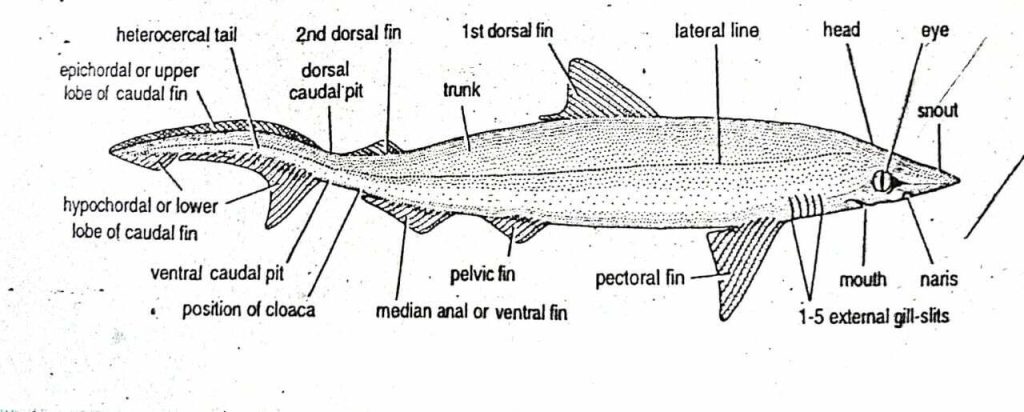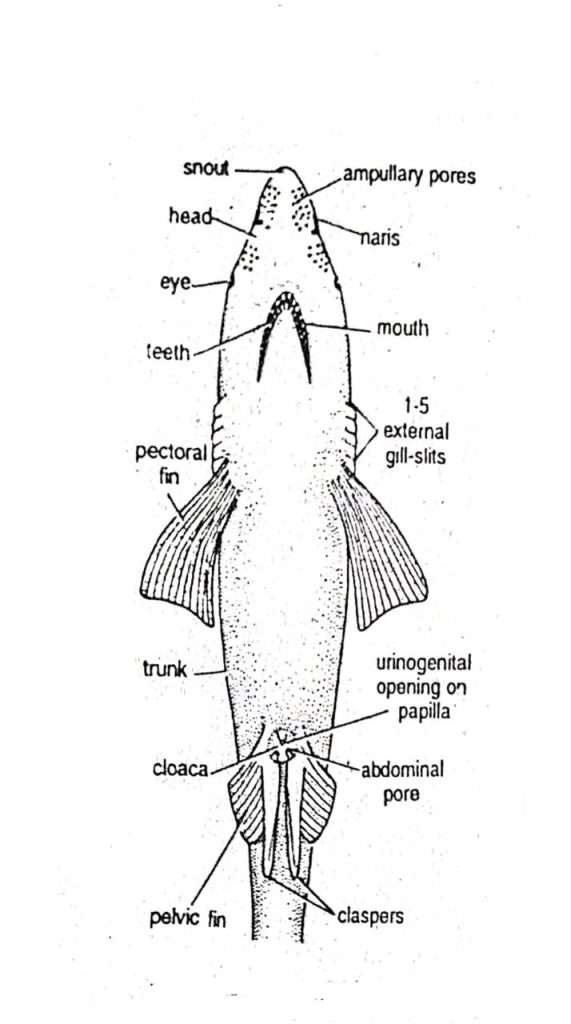In this article, we will learn the external morphology of Scoliodon or Dog Fish. The common name of Scoliodon is Dog Fish.
External Morphology of Scoliodon

fig: External morphology of Scoliodon (from lateral view)

fig: External morphology of Scoliodon – Dogfish (From ventral view).
1. Shape, Size, and Color
- The body of the Scoliodon is elongated, fusiform or spindle-shaped, and laterally compressed.
- Its highly stream-lined form reduces resistance to water, making movement easier and faster with minimum wastage of energy.
- A full-grown individual measures about 60 cm in length.
- The body is divided into head, trunk, and tail.
- The dorsal side of Scoliodon is dark-grey and the ventral side is pale white.
- The skin has placoid scales.
2. Head
- The head is dorso-ventrally flattened.
- Head merging insensibly into the trunk without a neck.
- At the anterior end of the head, there is a dorso-ventrally compressed wedge-shaped snout.
- The snout is pointed anteriorly.
- The mouth is located on the ventral side of the head.
- A pair of nostrils or nares are present just anterior to the mouth.
- Two circular eyes are present on the lateral side of the head.
- The external gill slits are present behind the eyes.
3. Trunk
- The trunk is almost oval in the transverse section and gradually tapers behind.
- It is the largest and thickest part of the body.
- Its thickest part lies in front of the middle of the body.
- Various fins and apertures are present in the trunk region.
4. Tail
- The tail forms the posterior half of the body.
- It is slightly bent upwards.
- It is laterally compressed.
- The type of the tail is heterocercal.
5. Eyes
- Two circular eyes are present one on each lateral side of the head.
- Eyelids are poorly developed and immovable.
- A movable nictitating membrane is present over the eyes.
6. Fins
The fins are an important part of the external morphology of Scoliodon.
- Appendages of the dogfish are fins.
- They are flap-like outgrowths of the body wall.
- They are directed posteriorly.
- The fins are supported internally by cartilaginous rods and horny fin rays.
- The Scoliodon has two types of fins and they are 1. unpaired or median fins and 2. paired or lateral fins.
Unpaired or Median Fins
-
-
- There are four unpaired or median fins present in the Scoliodon. They are two dorsal fins, one caudal fin, and one ventral or anal fin.
- The anterior dorsal fin or the first dorsal fin is triangular, larger, and present at about the middle of the body.
- The posterior or second dorsal fin is also triangular but much smaller than the first dorsal fin. It is located between the first dorsal fin and the tip of the tail.
- The caudal fin is present in the posterior part of the tail region. It is heterocercal and divided into two lobes. The upper lobe or epichordal is reduced and the lower lobe or hypochordal is well developed. The lower lobe is then further divided into two parts: the anterior and the posterior part.
- The ventral or anal fin lies about 5 cm in front of the caudal fin.
-
Paired or Lateral Fins
-
-
- The pectoral and pelvic fins are the lateral fins of Scoliodon.
- They are triangular and attached ventro-laterally to the trunk region.
- The pectoral fins are located at the anterior of the pelvic fins and it is larger than the pelvic fins.
- The pelvic fins are much smaller and located at the posterior of the pectoral fins.
-
7. Body Apertures
The following important body apertures are present on the body of the Scoliodon. They are an important part of the external morphology of Scoliodon.
A. Mouth
-
-
- It is a transverse aperture located at the ventral side of the head.
- It is bounded by upper and lower jaws.
- Each jaw bears sharp and pointed teeth which are directed backwardly.
-
B. Nostrils / Nares
-
-
- Two nares are present on the ventral side of the head and anterior to the mouth.
- They are exclusively olfactory.
- They have no respiratory function as they are not connected to the mouth cavity internally.
-
C. External Gill Slits
-
-
- External gill slits are present behind the eyes on either side and anterior to the pectoral fins.
- They lead internally into the pharyngeal cavity.
- They are the respiratory organs.
-
D. Cloacal Aperture
-
-
- The cloacal aperture is present at the root of the tail and between the two pelvic fins.
- It is the common exit for digestive and urinogenital systems.
-
E. Abdominal Pores
-
-
- The abdominal pores are located on either lateral edge of the cloaca.
- The abdominal body cavity opens to the exterior through the abdominal pores.
-
F. Caudal Pits
-
-
- The caudal pits are present in the tail region, at the base of the caudal fin.
- The caudal pits are the characteristic feature of the genus Scoliodon.
-
G. Lateral line and pores
-
-
- A lateral line runs along on either lateral side of the head, trunk, and tail region.
- Beneath this lateral line, a canal is present. The canal opens to the exterior by minute pores.
-
H. Ampullary pores
-
-
- Several groups of minute ampullary pores open on the head and snout.
-
———-THE END———-
Read More:
- Digestive System of Scoliodon with Diagram | Dog Fish | Note
- Respiratory System of Scoliodon | Dog Fish | Diagram
- Urinogenital System of Scoliodon | Diagram | Note
- Nervous System of Scoliodon | Shark | Diagram
- Reproduction of Scoliodon | Dog Fish
- Structure, Development & Homology of Placoid Scales | Shark | Scoliodon
- Sense Organs of Scoliodon | Diagram
- General Characters of All Classes of Vertebrates.
Reference
1. Dogfish wiki